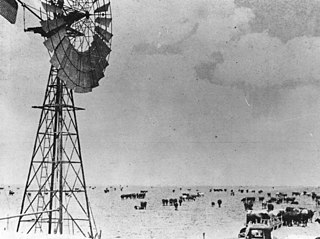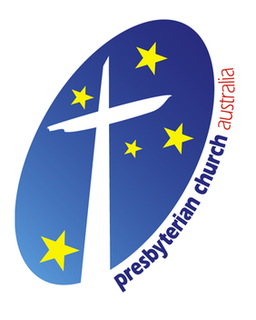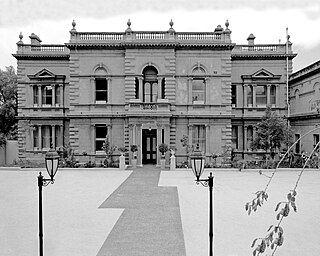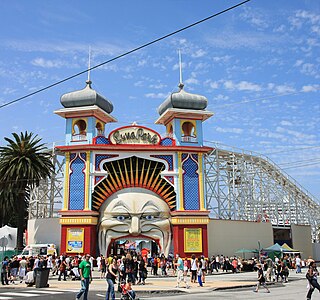
A sheep station is a large property in Australia or New Zealand whose main activity is the raising of sheep for their wool and meat. In Australia, sheep stations are usually in the south-east or south-west of the country. In New Zealand the Merinos are usually in the high country of the South Island. These properties may be thousands of square kilometres in size and run low stocking rates to be able to sustainably provide enough feed and water for the stock.

The Border Leicester is a British breed of sheep. It is a polled, long-wool sheep and is considered a dual-purpose breed as it is reared both for meat and for wool. The sheep are large but docile. They have been exported to other sheep-producing regions, including Australia and the United States.

The Romney, formerly called the Romney Marsh sheep but generally referred to by the local farmers as the Kent, is a breed of sheep originating in England. The Romney is a "long-wool" breed recognized in England by 1800. Exported to other continents, the Romney is an economically important sheep breed, especially to the sheep-meat and wool export trades of New Zealand.

The Peppin Merino is a breed of Merino sheep raised for their wool, mostly in Australia. So important is the Peppin Merino that wool producers throughout Australia often classify their sheep simply as being either Peppin, or non-Peppin.

The Rambouillet is a breed of sheep also known as the Rambouillet Merino or the French Merino. The development of the Rambouillet breed started in 1786, when Louis XVI purchased over 300 Spanish Merinos from his cousin, King Charles III of Spain. The flock was subsequently developed on an experimental royal farm, the Bergerie royale built during the reign of Louis XVI, at his request, on his domain of Rambouillet, 50 km southwest of Paris, which Louis XVI had purchased in December 1783 from his cousin, Louis Jean Marie de Bourbon, Duke of Penthièvre. The flock was raised exclusively at the Bergerie, with no sheep being sold for several years, well into the 19th century.

The Dorset Horn is an endangered British breed of domestic sheep. It is documented from the seventeenth century, and is highly prolific, sometimes producing two lambing seasons per year. Among British sheep, it is the only breed capable of breeding throughout the winter.

Noonkanbah Station is a pastoral lease, both a cattle and sheep station on the Fitzroy River between Camballin and Fitzroy Crossing. The station was pegged out in the 1880s and covered approximately 4,000 square kilometres or 1,000,000 acres in the south central Kimberley of Western Australia. It was the subject of an infamous land-rights dispute in August 1980 when state premier Sir Charles Court enforced an oil exploration project under police protection. The traditional owners now control around 1800 square kilometres of the land sacred to the Yungngora Community.
Alexander Riley was a merchant and one of the most important early pastoralists in Sydney and in New South Wales. Born in London to George Riley Snr, a well-educated bookseller, and Margaret Raby, he was the older brother of Edward Riley, also a merchant and pastoralist in Sydney. In 1804 Riley followed two of his sisters, who had married captains in the New South Wales Corps, Captain Ralph Wilson and Anthony Fenn Kemp, to Australia where, with his brother Edward who later followed, they went on to become two of Australia's richest men.

William Jarvis (1770–1859) was an American diplomat, financier and philanthropist best known for introducing the merino breed of sheep into the United States from Spain.

John Murray was a pastoralist and politician in Australia. He was a Member of the Queensland Legislative Assembly and the Queensland Legislative Council.

Bowes Station is a pastoral lease and sheep station located in the Mid West region of Western Australia.

Yakabindie is a pastoral lease currently a cattle station and previously a sheep station located about 31 kilometres (19 mi) north west of Leinster and 114 kilometres (71 mi) south of Wiluna in the Goldfields of Western Australia,

Nambi is a pastoral lease and sheep station located about 65 kilometres (40 mi) north east of Leonora and 110 kilometres (68 mi) south east of Leinster in the Goldfields of Western Australia,

Glenorn is a pastoral lease that has operated as both a sheep and cattle station. It is located about 40 kilometres (25 mi) south east of Leonora and 33 kilometres (21 mi) north east of Kookynie in the Goldfields of Western Australia,
John Murray and his son also named John Murray (1841–1908) were breeders of merino sheep in South Australia.

Charles Brown Fisher, generally referred to as C. B. Fisher, was an Australian pioneer pastoralist and livestock breeder.

Anlaby or Anlaby Station is a pastoral lease located about 12 kilometres (7 mi) south east of Marrabel and 14 kilometres (9 mi) north of Kapunda in the state of South Australia.

Avon Downs is a pastoral station on the Barkly Tableland in the Northern Territory of Australia. It is located 260 kilometres northwest of Mount Isa.

John Andrew Tennant "Jack" Mortlock was a pastoralist in South Australia, remembered as a major benefactor of the State Library of South Australia and commemorated by the "Mortlock Wing" of the library.



























